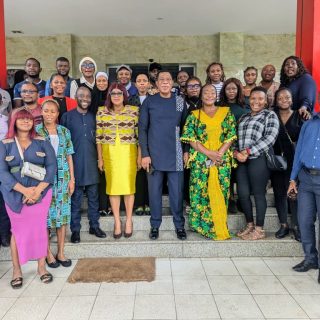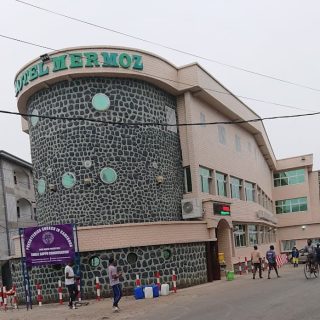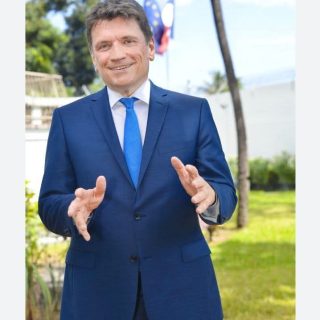WWF Accompanies Moloundou Municipal Council In Consultative Talks To Put In Place A Multi – Stakeholders Platform
Participants at the Nov. 14 meeting in Moloundou ended up adopting a decision to immediately set up the Multi –Stakeholders Platform in the area.
The platform will among other things ensure the rational and effective management of natural resources for the benefit of indigenous and local communities
The Moloundou Municipal Council in Boumba and Ngoko Division of the East Region of Cameroon, on November 14, 2024 played host to a consultation meeting of different actors in the municipality, with the objective of putting in place a Multi – Stakeholders Platform, that will promote the sustainable management of the natural resources of the area by different actors, and also promote contributions to local development, to the benefit of the indigenous and local communities. The consultation was organized by the WWF programme JENGI –TRIDOM, in collaboration with the Moloundou Council.
The workshop was officially opened by the DO of Mol;oundou, HOL MBENDA DIEUDONNE, who saluted the big come together for the important Multi –Stakeholders Platform Project, which is for the development of the sub –division. The DO expressed the administration’s gratitude to WWF, for accompanying the Moloundou Council, in the process to put in place the Multi –Stakeholders Platform.
Moloundou – The Border Town Surrounded By Two National Parks
Worthy of note, that Moloundou which is frontier town on the Cameroon side of the border with the Republic of Congo, is an area rich in biodiversity, which is unfortunately being threatened by poaching and logging. It should be noted that the Moloundou Municipality or Sub –division, is surrounded by the NKI and LOBEKE National Parks, within the TRIDOM and TNS landscapes.
The rich biodiversity of the Moloundou Municipality include emblematic wildlife species such as forest elephants and great apes. The indigenous people of Moloundou Municipality are the Baka and Bantu, and their economic activities revolve around subsistence agriculture, the collection and commercialization of non- timber -forest products, community forestry as well as hunting and fishing.
WWF Has Been Accompanying Gov’t In Sustainable Management For 30 Years
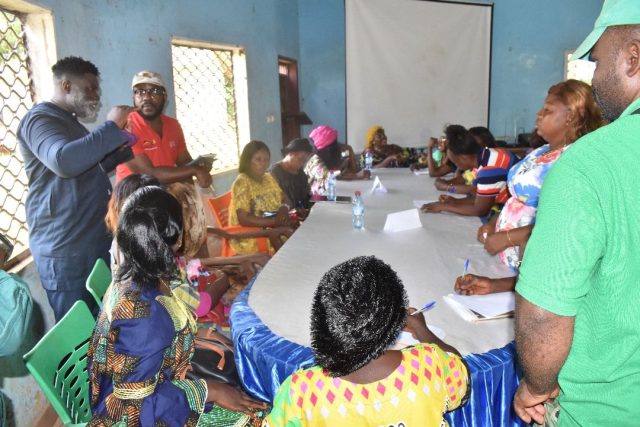
It is also interesting to note that WWF has for three decades now being accompanying the Cameroon Government in the sustainable management of natural resources. In the TNS and TRIDOM areas where WWF has been intervening since 1995, the organization’s role has been to provide both technical and financial assistance to the Government, as an assistance to accompany the Government to put in place its policy on conservation of biodiversity, and the sustainable management of natural resources.
In this light, WWF has also been accompanying local councils in forest zones in the East Region for example, to put in place Multi – Stakeholders Platforms, to ensure rational and effective management of natural resources, to the benefit of the indigenous and local communities. As WWF puts it, the Multi – Stakeholders Platforms “serves as concertation and collaboration forums for actors in the municipalities, as regard natural resources management and local development”. Before turning to Moloundou, WWF has previously supported or accompanied similar localities in the East Region, precisely DJOUM, MINTOM, NGOYLA and YOKADOUMA Councils, to put in place Multi – Stakeholders Platforms, in their different municipalities.
Absence Of Multi –Stakeholders Platform In Moloundou
It should be noted that many actors intervene in forest zones like Moloundou, rich in biodiversity. These actors include logging companies, sports hunting outfits, community organizations, civil society organizations, conservation services as well as technical and financial partners. All these actors play different roles linked to biodiversity management and local development. But the problem is that most often, the interventions and initiatives of these actors or stakeholders are not harmonized. Such a situation leads to low visibility, which is due mainly to the absence of a concertation platform for all the actors or stakeholders. Simply put, there is no coordination of interventions by the different actors. Besides the absence of the platform, there is also no follow – up of the actions or interventions by the different actors, to ensure that those actions actually contribute to the sustainable management of natural resources and the wellbeing of the local communities.
In the absence of coordination, there is disorder on the ground, leading a times to duplications of some actions or activities, as no actor in the area is aware of what another actor in the same area is planning to do. So there would a times be duplications of actions or activities. All these negative effects that are due to the absence of coordination and follow-ups, do not enable people of the different localities, to see or feel the real impact of actions carried out by some actors.
Advantages Of The Presence of Multi – Stakeholders Platforms
On the other hand, when a Multi –Stakeholders Platform is set up in a locality in the forest zone rich in biodiversity, there is order in the interventions of the different actors, as there is coordination on the ground. There is also a follow – up committee to ensure that all the activities, actions or interventions of the different actors, actually contribute to the sustainable management of the natural resources, as well as to the wellbeing of the indigenous and local communities. When there is a forum for concertation between stakeholders, there is transparency and the flow of information between stakeholders, as each knows what action or intervention the other actor is planning to carryout in the locality. Duplication of activities by some actors is thus avoided. Different actors also receive good orientation and advice. Meanwhile, local councils are thought to be in a better position to lead or head the Multi Stakeholders Platform in the different municipalities, as they normally enjoy legitimacy with institutions and communities.
Moloundou Council – Federator And Facilitator
Meanwhile the November 14, 2024 meeting for the consultation to put in place a Multi – Stakeholders Platform in Moloundou Municipality, was chaired by the Mayor of Moloundou, ALLO JEAN RICHARD. The main objective of the meeting was to sensitized or inform the stakeholders in the municipality of the importance and the opportunities, with the setting up of the Multi – Stakeholder Platform in Moloundou Municipality, and also to sensitize the stakeholders on how such a platform effectively functions.
The Moloundou Council is playing the role of federator and facilitator of the project to set up the Multi – Stakeholders Platform in the municipality. Though the project to put in place the Multi –Stakeholders Platform is the first ever in the municipality, the Moloundou Council is said to have played a similar role in the past in the coordination of actions in a project in favour of indigenous people. So the council has some experience in handling this type of projects.
Heavily Attended Meeting
The consultation meeting on November 14, 2024 in Moloundou saw a heavy attendance, which was definitely also a manifestation of the interest of the stakeholders in the meeting. There were a total of 110 participants at the meeting, comprised of 89 men and 21 women. Participants included representatives of local cooperative societies, representatives of economic operators, community organizations, traditional authorities, local NGOs, civil societies, International NGOs and partners of development, among others. Eight Government ministries were also represented. The ministries included MINADER, MINCOMMRCE, MINEPIA, MINEDUB, MINESEC, MINFOF, MINAS and MINSANTE.
Presentations And Discussions
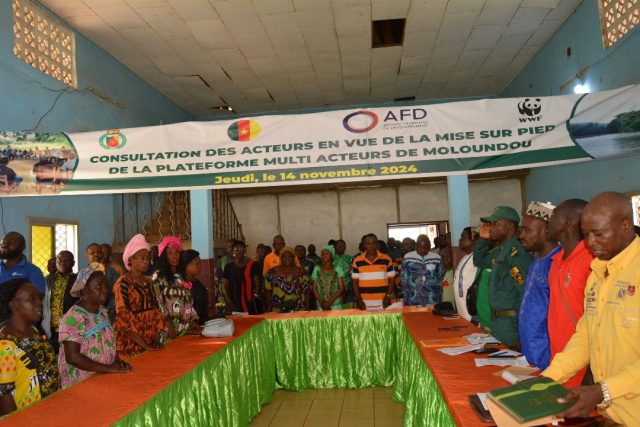
Presentations and discussions at the November 14 meeting in Moloundiou were on a number of important topics or issues, which included: 1) What the Multi –Stakeholders Platform is all about, including its role and functioning. 2) Conditions for the proper functioning of the platform. 3) The challenges, constraints, practices and attitudes that can obstruct or disturb the good functioning of the platform. 4) The different models of platforms. 5) The sharing of experiences on the functioning of existing Multi – Stakeholders Platforms in areas like Mintom and Ngoyla, in the East Region. 6) The mechanisms of communication and information of members of the platform. 7) Members selected for the follow – up committee, and why the choice of those members or groups. It should be noted that the discussions at the meeting were rich and fruitful.
Adoption Of Resolution For The Creation Of Multi – Stakeholders Platform
Interestingly enough, the November 14, 2024 meeting in Moloundou ended with the adoption of a resolution or decision to set up the Multi –Stakeholders Platform. It was also decided at the meeting that the platform will function according to the model of the General Assembly that will bring together all the parties or stakeholders. There will also be a follow – up committee charged to ensure the implantation in the field of the decisions of the platform. The platform will also serve as the forum of information exchange, sharing of experiences and advice to members, as well as to all actors that want to intervene in the sustainable management of natural resources in the Moloundou Sub – division. It was also decided at the November 14 meeting, that the platform will inform its members by either telephone, mails, sending messages through village chiefs, production of reports, among others.
Members of the follow – up committee were selected before curtains were drawn on the marathon meeting on that November 14. The Coordinator is the Mayor of Moloundou, ALLO JEAN RICHARD. Two of the mayor’s close collaborators including the 2nd Deputy Mayor, are also in the follow – up committee. All the major economic sectors in Moloundou Sub – division, including cooperative societies, the different agricultural sectors, all have representatives. Traditional authorities, NGOs, community organizations, indigenous and local communities, and so on, are also represented in the follow–up committee. It is interesting to note that one of the indigenous communities, the Baka people, are represented in the follow – up committee by ASBABUK, which will certainly defend their interest.
WWF – Promoting Participation Of Stakeholders In Sustainable Management
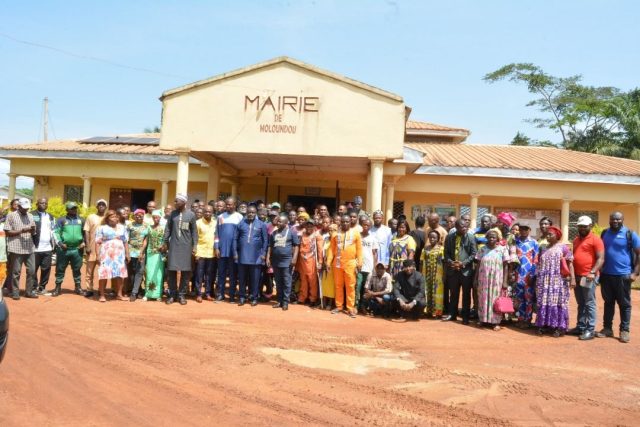
Suffice to say that the over 100 participants ended the November 14 meeting in Moloundou, on a very positive note, and with profound gratitude to WWF for the project, the Multi –Stakeholders Platform.
WWF also left the meeting with much optimism. “By supporting the putting in place of a multi –shareholders platform, WWF hopes to promote the participation of various actors in sustainable management of natural resources and contribution to local development. The Moloundou platform will serve as a discussion and brainstorming forum, that brings together all relevant actors concerning projects and initiatives within the landscape”, MOISE KONO, the Indigenous People Coordinator, WWF Cameroon, stated at the end of the November 14 meeting in Moloundou.
By Joe Dinga Pefok (Uncle Joe)
Website: www.thementornews.com
Facebook: The Mentor
Email: djpefok@yahoo.com / djpefok13@gmail.com
Contacts: Telephone /WhatsApp: (237) 699 71 83 92 / 677 17 54 51


